Welcome, everyone who loves dogs or worries about their pets! Today, we’re going to talk about dog tumors, which may sound scary but is very important for all fur babies’ health. Before your worry takes over, you can rest assured that this complete guide of your dog tumors will teach you important things about the most common kinds of dog tumors. Learn the difference between normal and dangerous growths, as well as the warning signs and treatment choices. Think of us as your trusted guide on this educational trip. So, grab a treat for Fido, relax, and let’s learn everything we can about the health problems of these amazing dogs.
A Brief Look at Dog Tumors
Dog owners often worry about their pets’ health when they find lumps on their dogs. These strange growths can appear anywhere on a dog’s body, even in the bones, skin, and organs. Even though not all tumors are dangerous, it is important to have them checked out by a vet to find out what kind they are and how to treat them.
Dog tumors can be broken down into two major groups: normal and cancerous. Benign tumors are growths that are not dangerous and don’t spread to other parts of the body. These things tend to grow slowly and don’t hurt a dog’s health unless they get too big and hurt or stop important processes from working. Cancerous growths, on the other hand, are called malignant tumors. They can spread to nearby tissues or even to other parts of the body through the bloodstream or lymphatic system.
There are many things that can cause dog tumors, including genetics, age, gender, and exposure to some harmful chemicals in the surroundings. Certain genetic traits may make some types of tumors more likely to form in certain breeds, and older dogs are more likely to get them because their immune systems are weaker. Not having their mammary glands spayed also makes it more likely for female dogs to get these tumors.
A common misunderstanding about dog tumors is that they only happen to older dogs. Even though getting a tumor is more likely as a dog gets older, these strange growths can also happen to young dogs. Younger dogs are more likely to get some types of cancer, like osteosarcoma (bone tumors) and hemangiosarcoma (blood vessel tumors).

Dog tumors can cause different symptoms based on where they are and what kind they are. Some common signs to look out for are hard or wavy skin growths or lumps, changes in behavior or hunger, weight loss, trouble breathing or swallowing, and feeling tired all the time. If you notice any strange changes in your dog’s look or behavior, you should take note of them and get professional help from a vet if needed.
Dog tumors are diagnosed with a full physical check, imaging tests like X-rays or ultrasounds, and maybe even a biopsy to find out what kind of tumor it is. The dog’s general health and the type, size, and location of the growth will determine the best way to treat it. Surgical removal of benign tumors is an option if they are bothersome or getting in the way of normal activities. Some types of malignant tumors may need more than one type of treatment, like surgery, chemotherapy, radiation therapy, or immunotherapy.
To sum up, pet owners may find the word ” dog tumors” scary, but it’s important to remember that not all tumors are dangerous, and that finding and treating a dog’s tumor early can make its outlook much better.
Types of Cancerous Growths of Dog Tumors
It’s important to know that not all growth in Dogs, Dog Tumors are dangerous. Additionally, some tumors that can happen in dogs are thought to be benign, which means they don’t pose a major health risk to your dog. But you should still keep an eye on these lumps and take care of them because they can hurt your dog and lower his quality of life.
Here are a few of the most common types of benign glands found in dogs:
- Most of the time, lipomas are found to be benign tumors in dogs. They generally show up under the skin as soft, moveable lumps and get bigger slowly over time. Lipomas are made up of fat cells and tend to happen to older dogs or dogs with a genetic risk.
- These are small, fluid-filled sacs that form under the skin when hair shafts or oil glands get clogged or irritated. Anywhere on a dog’s body can get them. They might feel like small peas under the skin. Most of the time, you don’t need to treat sebum cysts unless they get sick or make your dog uncomfortable.
- Papillomas: These are growths that are often found on the eyes, lips, mouth, heel pads, and genitals. They are also called “skin tags.” Most of the time, they are safe, but if they are in a place that hurts your dog (like rubbing against their eye), a vet may need to take them out.
What it means and some common examples of Dog Tumors:
Dog tumors are growths of cells that don’t look right and can happen in different parts of the dog’s body. Tumors can be normal, which means they are not dangerous, or malignant, which means they are. Most of the time, benign tumors are safe and don’t spread to other parts of the body. On the other hand, cancerous tumors can attack tissues and organs around them.
These are the most common types of dog tumors:
- Fat lumps:
One of the most common types of tumors found in dogs is lipomas. These round, soft, fatty lumps show up on dogs that are middle-aged or older and can be found anywhere on the body. Most of the time, they are harmless, but they can be a problem if they get too big or get in the way of regular movement.
- Mast cell growths:
Mast cell tumors affect the mast cells in a dog’s skin. These cells are what release histamine when the dog has an allergic response. These tumors can be harmless or very dangerous, and they tend to grow quickly.
- Mammary Gland Growths:
These growths happen most often in female dogs that haven’t been spayed or neutered. They can appear in any of the mammary glands on the belly. Most lumps in the mammary gland are harmless, but some can be cancerous, so finding them early is very important for a good treatment.
- Bone sarcoma:
Large dog breeds like Great Danes, Rottweilers, and Doberman Pinschers are more likely to get osteosarcoma, a type of bone cancer. This growth often starts in the limbs and can grow quickly, spreading to other parts of the body.
- Hemangiosarcoma:
Hemangiosarcoma is a cancerous growth that affects blood vessels. It can happen in the lungs, heart, liver, skin, and subcutaneous tissue, among other places. This type of cancer is very likely to metastasize, or spread to other parts of the body.
- A lymphoma:
Cancer of the lymphatic system is called lymphoma. It can happen anywhere in the body where there is lymph tissue. It is one of the most common types of dog tumors in dogs and can show up as swollen lymph nodes, losing weight, and being tired all the time.
- Cancers of the squamous cells:
Squamous cell carcinomas are growths that show up on a dog’s skin or nasal tissues. They usually grow slowly, but if you don’t treat them, they can spread and become life-threatening.
If you see any lumps or bumps on your dog’s body that don’t seem right, you should take them to the vet so they can properly diagnose and fix the problem. If you find and remove lumps early, your dog has a much better chance of getting better.
Signs and a diagnosis of Dog Tumors:
Symptoms and a proper evaluation are very important for finding and curing dog tumors. In this part, we’ll talk about the most common signs of different kinds of dog tumors, as well as the different ways that vets can tell if a dog has one.
Noted signs of dog tumors:
The signs of a dog tumor depend on where it is, how big it is, and what kind of growth it is. Some dogs might not show any symptoms at all, while others might show a lot of them. It’s important to remember that not all lumps or growths on dogs are dangerous. But it’s better to be safe than sorry, so if you notice any strange changes in your dog’s body, you should take him to the vet.
Some of the most common signs (Dog Tumors) that your dog has a tumor are:
- Lump or bump that can be seen: Most types of dog tumors feel like lumps or bumps under the skin. They can be as small as pea-sized bumps or as big as masses that can be seen.
- Changes in how you look: Dog Tumors that are close to or on the surface of the skin can make the area red, swollen, or hairless.
- Strange discharge: If your dog has strange discharge from any part of their body, like blood or pus, it could mean they have a growth underneath.
- Problems with eating or swallowing: If a dog has a tumor in its mouth, throat, or stomach, it may be painful or impossible for the dog to eat or swallow because of the mass.

A Full Guide to the Most Common Types of Dog Tumors 2024
- Limping: Dogs can be lame and limp when they have tumors that affect their bones and joints.
- Loss of weight: Some types of dog tumors can make dogs lose their hunger, which can cause them to lose weight.
- Changing how you go to the bathroom: Dog tumors can press on the organs or structures around them, which can change how you urinate or defecate.
- Having trouble breathing: Dogs can have trouble breathing properly if they have tumors near their lungs.
- Behavioral changes: Because the growths make it hard for the dogs to do normal things, they may show signs of pain, tiredness, or irritability.
Figure out:
If you see any of these signs in your dog, you need to take them to the vet right away to get a correct evaluation. Veterinarians use the following ways to find out if a dog has a tumor.
- Physical examination: A vet will give your dog a full physical examination, which will include feeling and looking at any lumps or bumps on their body.
- Imaging tests: X-rays, ultrasounds, and MRIs are often used to find dog tumors in dogs and figure out where they are and how big they are.
- Biopsy: A small piece of tumor tissue is taken and looked at under a microscope to find out if it is dangerous and what kind of cancer it is.
- Blood tests: Some signs in a dog’s blood can show that there is a growth, but this method isn’t always accurate.
- Fine needle aspirate: A tiny needle is put into the growth to take out cells that can be looked at under a microscope.
Once the type of growth and its site have been found, your veterinarian will talk to you about your treatment choices. You should take your dog to the vet right away if you think they might have a growth so that they have a better chance of getting better.
Possible treatments of dog tumors:
Dog tumors can be treated in different ways, based on the type, position, and size of the growth. A vet should be consulted to figure out the best course of action for your pet friend. For different kinds of dog tumors, these are some popular ways to treat them.
- Surgical procedure:
Most of the time, surgery is the best way to treat most kinds of dog growth. It includes taking out both the growth and the good tissue around it from the affected area. How well surgery works depends on things like the type, size, and location of the growth.
- Getting chemotherapy:
Chemotherapy is a total body treatment that kills cancer cells by going after them. For Dog Tumors and cancers that don’t want to spread to other parts of the body, it can be used before or after surgery.
- Therapy with radiation:
High-energy rays are used in radiation treatment to target and kill cancer cells. This treatment is usually only used for growth that surgery can’t get rid of fully or when surgery isn’t a choice.
- Using immunotherapy:
Immunotherapy works by getting the body’s immune system to find and fight cancer cells. This method of treatment has shown promise in helping dogs with certain types of cancer.
- Freezing surgery:
During this process, liquid nitrogen or carbon dioxide gas is used to freeze and kill unwanted tissue. Veterinarians may suggest cryosurgery for smaller lumps that are close to sensitive parts of the body, like the eyes or toes.
- Trained therapy:
Targeted therapy refers to medicines that go after the exact genetic changes or proteins that are making cancer cells grow. This kind of treatment has shown promise in getting rid of some types of dog cancer.
- End-of-life care:
Palliative care for dogs with advanced tumors focuses on taking care of their symptoms and making their quality of life better. This could include helping with pain, diet, and other types of compassionate care.
Please keep in mind that these treatment choices might not work for all kinds of cancers and could also cause side effects. You and your vet will work together to make a care plan that fits your dog’s specific needs.
Types of Dog Tumors Growth:
There are different kinds of growth that can happen in dogs, and they are either normal or cancerous. A benign tumor is a growth that is not cancerous and does not spread to other parts of the body. A malignant tumor, on the other hand, is a growth that is cancerous and can attack nearby tissues and spread to other organs. This part will talk about the different kinds of dog tumors growth that can appear in dogs.
- Mast Cell Growths
One type of skin cancer that dogs often get is called a mast cell tumor (MCT). Mast cells are a type of white blood cell that makes them. Mast cells help with allergic responses. MCTs can happen anywhere on a dog’s body and may show up as raised bumps or lumps under the skin. There are different grades of these tumors, from low-grade (not very dangerous) to high-grade (very dangerous). It is very important to have any lumps that seem odd checked out by a vet to see if they are MCTs.
- Bone sarcoma
Osteosarcoma is a bone cancer that grows quickly and usually affects big dogs like Great Danes, Rottweilers, and Greyhounds. It often forms in places where bones are growing quickly, like the long bones of the legs and the bones in the upper arm near the shoulders. Pain, stumbling, swelling around the joints, and breaks in bones due to weakening may be signs.
- Mammary Gland Growths
Mammary gland tumors are more likely to happen in female dogs that have not been fixed. This risk rises with age. These growths may look like lumps in the breast tissue and may or may not be cancerous. It is important to find and remove these tumors as soon as possible because they can spread to other areas if they are not handled.
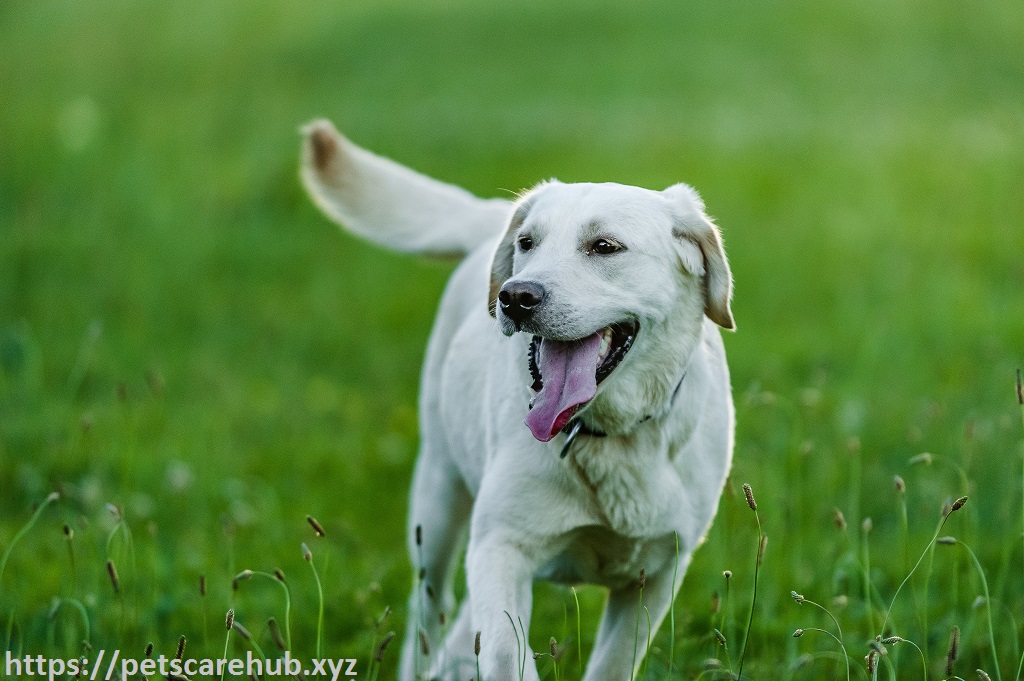
- Malignant melanoma
Melanoma is a type of skin cancer that affects melanocytes, which are skin cells that make color. This kind of cancer can happen anywhere on a dog’s body, even in the eyes, mouth, and toes. It happens more often in older dogs and can make them violent, so finding it and treating it quickly is very important.
- A lymphoma
Lymphoma is a type of cancer that affects the lymphatic system. The lymphatic system cleans the body of germs and fights them. It can happen anywhere there is lymph tissue, but lymph nodes in the neck or behind the knees is where it happens most often. Some of the signs are swollen lymph nodes, feeling tired, losing your appetite, losing weight, and having trouble breathing.
- Blood vessel cancer
HSA is a kind of cancer that starts in cells of blood vessels and can happen in any organ or tissue that has blood vessels. It happens most often in the heart and lungs, but it can also happen in the brain, skin, and other parts of the body. It can be hard to find HSA because it might not show any signs until it is very far along.
- Sarcomas of soft tissues
Many types of cancer start in connective tissues, like nerves, blood vessels, fat, and muscle. These are called soft tissue sarcomas (STS). They can happen anywhere on the body and show up as bumps on the skin or deeper in the tissue. STS grows slowly most of the time, but it can be active and hard to get rid of fully.
- Cancer of Transitional Cells
A type of cancer called transitional cell carcinoma (TCC) grows in the cells that line the urine bladder, duct, or ureters. Female dogs and older male dogs that haven’t been fixed are most likely to get it. Symptoms may include having trouble peeing, having red urine, or having to go to the bathroom a lot.
- Brain growths
Brain tumors in dogs are not very common, but they can happen to any breed at any age. These tumors can come from different kinds of brain cells and, based on where they are in the brain, may cause a variety of symptoms. Some signs are seizures, trouble walking, changes in behavior and trouble seeing.
- Cancers of the feces
Adenocarcinomas are a type of cancer that can happen in the glandular cells of the lungs, liver, and intestines, among other places. These growths can be dangerous and quickly spread to other parts of the body. Depending on where the growth is, symptoms may include feeling tired, losing your appetite, losing weight, and having trouble breathing.
- Cancer of the Squamous Cells
One kind of skin cancer that affects cells on the skin’s surface is squamous cell carcinoma (SCC). It usually shows up on parts of the body with little hair, like the tips of the ears, nose, and lips. SCC can also happen in the mouth or near the nail beds. To keep these cancers from moving to other areas, treatment is very important.
- Hormonal sperm
Astrocytoma is a kind of brain tumor that starts in astrocytes, which are star-shaped cells in the brain that help nerve cells work. Large dogs, like Golden Retrievers and Boxers, are more likely to get it, and older dogs are more likely to get it too. Some signs are seizures, trouble walking, and changes in behavior or vision.
- Lymphoma-like growths
Adenomas are harmless growths that can happen in the glands of many body parts, like the thyroid, pituitary gland, mammary glands, and liver. Even though they aren’t dangerous, the size and location of them may still make you sick. If these tumors are found early, they may not grow into dangerous adenocarcinomas.
- Sarcoma of the fibroblasts
There is a type of soft tissue sarcoma called fibrosarcoma that grows in flexible tissues like muscle fibers, tendons, and ligaments. They can happen anywhere on the body, but most often on the arms, legs, or back. These tumors are often aggressive and hard to get rid of completely.
- An Insulinoma
An insulininoma is a kind of pancreatic cancer that affects the cells that make insulin, a hormone that controls the body’s blood sugar levels. Dogs that are middle-aged or older are most likely to get it. Low blood sugar can make them weak, lethargic, have seizures, or even pass out.
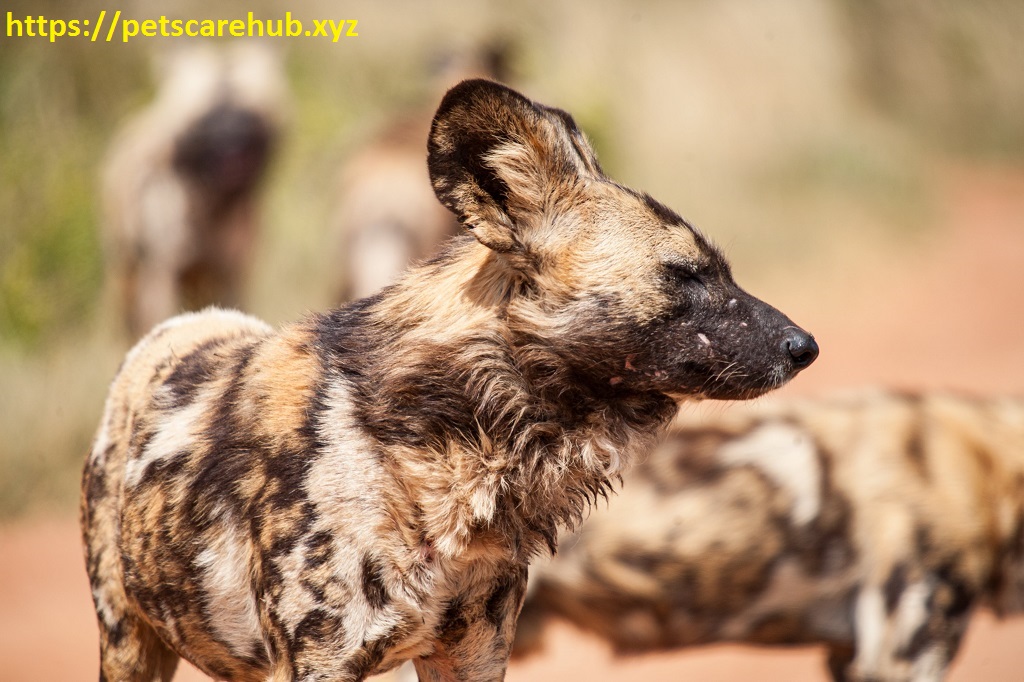
- Papilloma of the skin
Squamous papilloma is a common type of skin growth in dogs that is harmless. It is caused by a virus known as canine papillomavirus (CPV). People usually get these spots on their lips, mouth, or eyes. They can be different sizes and look different. Even though they aren’t dangerous, they can be annoying if they’re in sensitive places.
- Joint Sarcoma
This is a kind of bone cancer that affects the cells that make up the cartilage at the ends of bones. Large types like Rottweilers are most likely to get it. Pain, stumbling, swelling near the joints, and broken bones are some of the signs.
- Cancer of the lymph nodes
This is a kind of cancer called lymphosarcoma that affects the lymphatic system and white blood cells known as lymphocytes. It can happen in any organ or tissue with lymphatic tissue, but it happens most often in the chest or belly. Some of the signs are swollen lymph nodes, losing weight, feeling tired, and having trouble breathing.
- Brown cell mass
Melanocytomas are harmless growths that start in melanocytes, the cells in your skin and hair shafts that make color. Most of the time, these tumors show up on dark spots like lips and paw pads, and they are more common in dogs with dark coats.
- Venereal tumors that can be passed on
One type of cancer that can be passed from dog to dog through direct touch is called transmissible venereal tumors (TVTs). The genitalia of wild or sexually adventurous dogs are most likely to have these tumors, which look like cauliflower-like growths.
Remember that finding and treating any kind of growth as soon as possible is very important for a better chance of success. If you notice any lumps or bumps that don’t seem normal or if your dog’s behavior changes, you should take him or her to the vet to be checked out and treated.
What it means and some common examples:
Neoplasms, which are another name for dog tumors, are growths of cells that don’t belong in a dog’s body. These growths can be normal, which means they are not dangerous, or malignant, which means they are. They can happen on the skin, lungs, bones, or any other part of the dog’s body.
Most of the time, benign dog tumors grow slowly and don’t spread to other parts of the body. There are several kinds of normal lumps that dogs often get. One example is lipomas, which are growths of fat that usually happen under the skin. Papillomas are another common type. They are small growths that look like warts and often show up in groups on a dog’s skin.
If you have a cancerous growth, on the other hand, it can grow quickly and spread to other parts of your body. The mast cell tumor is the most common type of cancer in dogs. It grows from mast cells, which are a type of white blood cell. For example, osteosarcoma is cancer of the bones, hemangiosarcoma is cancer of the blood vessels, and lymphoma is cancer of the lymph nodes.
While these are the two main types of dog tumors, there are other types that pet owners should know about as well. Melanomas (skin cancer), mammary gland tumors (breast cancer), and histiocytomas (benign skin tumors) are some of these. There may also be breeds that are more likely to get certain types of tumors. For example, boxers are more likely to get mast cell tumors, while golden retrievers are more likely to get lymphoma.
Dog tumors can be very different in size, shape, and look. Some might be small and hard to find, while others might be big and easy to see. If a dog owner sees any strange growths on their pet, they should take them to the vet to get checked out. Early discovery and the right treatment can greatly improve a dog’s chances of having a tumor removed and getting better overall.
Dog tumors sign and how to diagnose them:
Because you own a dog, you should know what signs your pet friend might show if they have a growth. You may be able to see or feel some tumors through lumps on the skin, but others might not be obvious until they have grown a lot.
Here are some signs that you should be aware of dog tumors:
- Strange lumps or bumps: Strange lumps or bumps on a dog’s body are the most obvious sign that they have a tumor. These can be any place on their skin, under their fur, or even inside them. They come in different sizes and shapes.
- Behavioral changes: If your dog all of a sudden seems tired or loses interest in things they used to enjoy, it could mean that something is wrong. Some tumors can be painful or uncomfortable, which can change how you act or feel, like having less energy.
- Trouble breathing or swallowing: If your dog has a tumor near its throat or lung system, it may have trouble breathing or eating. This needs to be taken seriously because if it isn’t managed, it could lead to major problems.
- Weight loss: If your dog is losing weight even though it is hungry, it could be a sign of some types of cancer, like those that affect the digestive system.
- Any strange discharges: You shouldn’t ignore any strange discharges coming from your dog’s body because they could be signs of an illness caused by a growth.
If you notice any of these signs, you should talk to your doctor right away. They will give your dog a physical check and may suggest more tests, like imaging or a biopsy, to find out if he has a growth.
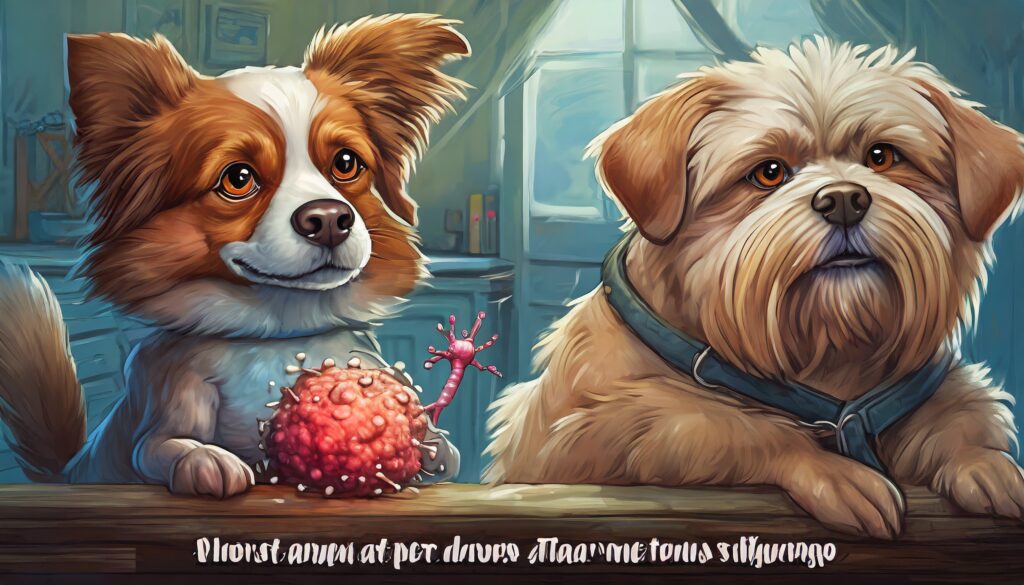
Also, it’s important to remember that not all lumps are dangerous. In fact, most lumps on dogs are harmless (not dangerous). They should always be checked out by a doctor, though, to make sure they get the right evaluation and treatment plan.
Possible treatments of dog tumors
Different types, sizes, and locations of dog tumors, as well as the dog’s general health, affect the treatments that can be used. Sometimes, surgery is the only way to get rid of a growth for good. Some people may need radiation therapy or chemotherapy to get the tumor to shrink or grow more slowly.
- Surgical procedure for dog tumors:
When a dog’s growth is localized and hasn’t spread to other parts of the body, surgery is often the first choice for treatment. The success of surgery relies on many things, like how quickly the growth is found, where it is located, and the dog’s general health. A veterinarian will remove all visible signs of the tumor during surgery, along with a small area of healthy tissue around it. This makes sure that any cancerous cells that are still there are also killed.
- Therapy with radiation:
Through radiation therapy, high-energy rays are used to kill cancer cells in certain body parts where tumors are found. It can be used on its own or along with other treatments like surgery or chemotherapy of some kind. It can help ease symptoms and improve quality of life, but it can’t stop all cancer cells from spreading in a dog’s body.
- Getting chemotherapy:
Chemotherapy uses drugs to kill cancer cells by focusing on cells in a dog’s body that divide quickly. It is usually given through an IV, but depending on the type and stage of cancer, it can also be taken by mouth or put on the skin.
Chemotherapy is often used along with surgery to stop cancer cells that have broken off from the main tumor from coming back or spreading. It can also be used as a palliative treatment to help dogs with advanced tumors feel better and have less pain.
- Using immunotherapy:
In immunotherapy, the immune system of the body is used to fight cancer cells. It gets the immune system going by making more white blood cells and cytokines, which help kill cancer cells or slow their growth. It’s possible to use this treatment by itself or with other treatments.
- Targeted Medical Care:
When you use targeted therapy, you only treat molecules or receptors that are involved in the growth and development of cancer. By blocking these molecules, targeted therapy can stop tumors from growing and make it more likely for dogs to survive.
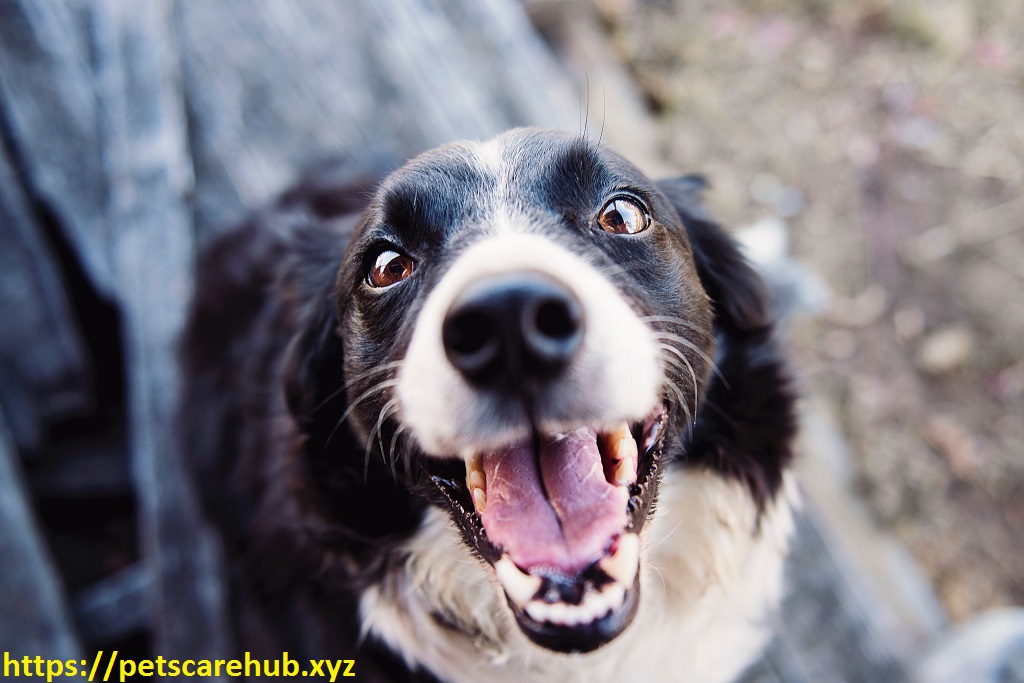
- Different types of therapy:
As an alternative way to treat their dog’s tumor, some pet owners may also choose to try herbal medicine, acupuncture, or homeopathy. Even though these choices might help with some symptoms, there isn’t a lot of scientific proof that they can cure tumors.
Before you try any alternative therapies on your pet, you should talk to a vet because they might not work for all types of tumors and might get in the way of regular treatments.
How to Understand Dogs Tumors:
Dogs of all breeds, ages, and sizes can get cancer, which is a very bad disease. One out of every three dogs will get some kind of cancer at some point in their lives. As pet owners, we need to know about the different kinds of cancer that can happen to our furry friends and how we can help stop, find, and treat them.
Dogs can get different kinds of dog tumors, but the most common ones are:
- Mast Cell Tumors:These tumors come from mast cells, which are found all over the body and help the immune system. They usually show up as bumps on or under the skin, but they can also happen inside the body.
- Lymphoma: This kind of cancer, which is also called lymphosarcoma, starts in lymphocytes, which are white blood cells that fight infections. A lot of the time, it starts in the lymph nodes and spreads to other parts of the body.
- Osteosarcoma: The dog breeds Great Danes, Rottweilers, and Saint Bernards are most likely to get osteosarcoma, a type of bone cancer. Usually it starts in one limb, but quickly it can spread to other bones or organs.
- Melanoma: This tumor starts in melanocytes, the cells that give skin its color. Melanomas usually show up as dark bumps on the skin or in the mouth of a dog, but they can also happen inside the body.
- Mammary gland tumors: Dogs that have not been spayed or neutered are more likely to get mammary gland tumors than male dogs. Most of the time, they show up as lumps on the mammary glands, which are on the belly of the dog.
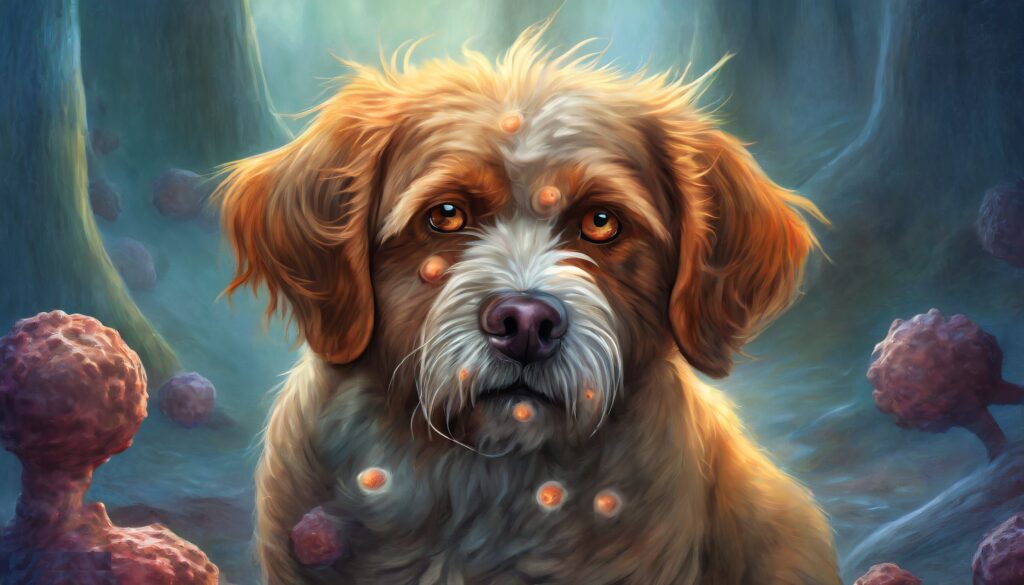
Dogs can get different kinds of dog tumors
What makes dogs get cancer?
It’s not always clear why dogs get cancer, but studies have shown that some things can make their chances of getting cancer higher. Some of these factors are:
- Age: Just like people, older dogs are more likely to get cancer.
- Genetics: Because of their genes, some breeds are more likely to get certain types of cancer.
- Pollutants in the environment: Secondhand smoke and pesticides, have been linked to a higher risk of cancer in dogs.
- Diet: Not getting enough food and being overweight can also make a dog more likely to get cancer.
Signs that your dog has cancer:
Cancer symptoms depend on the type of tumor and where it is located, but here are some common ones:
- Body bumps or lumps that don’t belong there
- Loss of weight and changes in hunger
- Not being able to breathe or urinate
- Feeling tired and having less energy
- Being weak or limping
- Anywhere on the body bleeds.
- A bad smell or having trouble eating.
If any of these things happen to your dog, you should take them to the vet right away for a full checkup.
How to treat and stop dog tumors:
Surgery, chemotherapy, and radiation therapy are the most common ways to treat cancer in dogs. Treatment, on the other hand, is based on the type and stage of the dog tumors.
Because it’s always better to avoid something than to fix it, here are some things you can do to lower your dog’s risk of getting dog tumors:
- If you spay or neuter your dog, their risk of getting mammary gland dog tumors goes down.
- Keep them at a healthy weight. Dogs that are overweight are more likely to get dog tumors.
- Stay away from things that can cause cancer. Keep your dog away from secondhand smoke, pesticides, and other harmful things in the environment.
- Give them a well-balanced diet. A healthy diet with lots of fresh fruits and vegetables can help your dog’s immune system and lower their risk of getting cancer.
- Regular check-ups with your vet: Finding cancer early is very important for treating it, so make sure to schedule regular check-ups with your veterinarian.
- Keep an eye out for any changes in your dog’s behavior or appearance. Look for any new lumps or bumps and note any changes in your dog’s energy level and appetite.
To sum up, cancer is a dangerous and common disease in dogs tumor, but it can be treated effectively with the right care and early detection. We can help keep our furry friends healthy and happy by learning about the different kinds of cancer and taking steps to avoid getting them.
What causes it and what makes it dangerous of dog tumors?
To better understand dog tumors, it’s important to know what causes them and what kinds of things can make them more likely to happen. There isn’t a single cause for all types of dog tumors, but there are a number of things that have been identified as likely to cause dog tumors to grow.
- Biology: Genetics
Some types of dog tumors can be caused by genes that make them more likely to build up. It has been seen that some breeds are more likely to get certain types of tumors because of genetic changes that are passed down. Boxers, for instance, are more likely to get mast cell dog tumors, while Golden Retrievers are more likely to get lymphomas.
- Things in the environment:
Dogs have been linked to getting different kinds of cancerous growths after being exposed to environmental toxins and carcinogens. This includes being close to cigarette smoke, pesticides, herbicides, and household cleaners. Additionally, dogs can be more likely to get skin dog tumors if they are exposed to too much UV radiation from the sun.
- Age:
Like people, a dog’s age is often a big factor in how likely it is that it will get dog tumors. Older dogs are more likely to get it because their immune systems are weaker or their cells have worn down over time, making them less able to fight off abnormal cell growth.
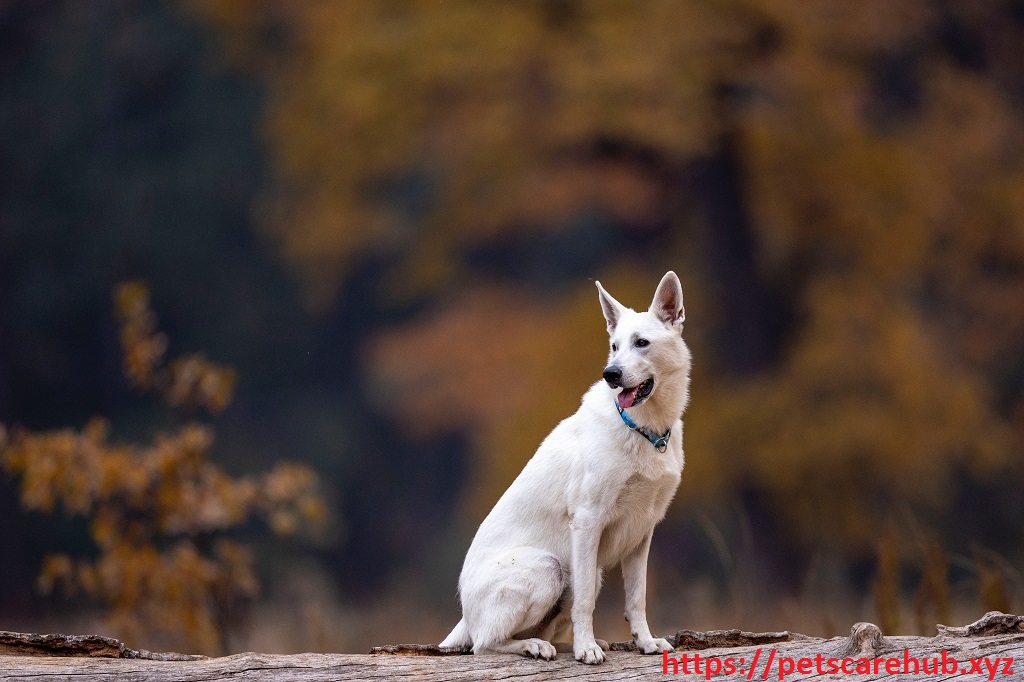
- Imbalances in hormones:
Many bodily functions depend on hormones, and when they are out of balance, it can cause health problems like tumors in dogs. For example, female dogs that haven’t been spayed are more likely to get mammary gland tumors because they are exposed to estrogen for longer periods of time. Several types of dogs tumors have also been linked to a hormone known as insulin-like growth factor (IGF).
- Being overweight:
Some types of dog tumors, like mammary gland tumors and lipomas (fatty tumors), are more likely to happen if the dog is overweight. This is because having too much body fat can cause long-term inflammation, which can help dog tumors.
- Long-Term Inflammation:
When you have an infection or get hurt over and over again, it can cause chronic inflammation. This can damage cells and their DNA, which can cause tumors to grow. Dogs that already have inflammatory conditions, like allergies or autoimmune diseases, may be more likely to get dogs tumors.
- Immune System Weakness:
A strong immune system is very important for finding and getting rid of abnormal cells that might turn into cancer. However, if a dog’s immune system is weak because of genetics or a health problem, it might not be able to stop the growth of a dogs tumor.
- Spaying or neutering:
Spaying female dogs before their first heat cycle can make them much less likely to get breast cancer later in life. Having a male dog neutered also makes it less likely that they will get testicular cancer and other types of dog tumors.
In conclusion, there are a lot of possible causes and risk factors for dog tumors, but it may still be impossible to say for sure why a certain dog gets a tumor. It is important to keep an eye on your dog’s health and see a vet if you notice any lumps or changes in how your dog acts. Dogs are less likely to get tumors if they get regular checkups, take preventative steps like getting spayed or neutered, and stay away from environmental toxins.
Ways to stop dog tumors:
It is always better to avoid something than to fix it, and this is also true for dog tumors. Even though some types of tumors can’t be stopped, pet owners can take some steps to make it less likely that their animals will get them. The next part of this article will talk about some good ways for dog owners to keep their pets healthy and free of dog tumors.
- Regular check-ups with the veterinarian: The best way to keep your dog healthy is to know about any health problems that might be happening. Getting regular check-ups with a vet you trust can help with this. During these visits, the vet will do a full physical exam and may also suggest routine diagnostic tests like blood work or X-rays to find any problems early on.

- Healthy Food: A well-balanced diet is very important for keeping a dog’s immune system strong against dog tumors. It is very important to feed your dog good food that meets their nutritional needs based on their age, breed, and size. To keep your dog from getting dog tumors, don’t give them table scraps or foods that are high in preservatives and by-products.
- Regular exercise: Just like for people, exercise is important for dogs’ health. Regular exercise helps you keep a healthy weight, builds muscle and bone strength, improves heart health, and boosts your immune system. All of these things are very important for preventing tumors.
- Be aware of what your dog is doing around you: Dogs are naturally curious, and they will often lick or eat things they find while they are exploring. It’s important to keep an eye on your dog and keep him out of places that might have harmful things in them, like pesticides, poisonous plants, chemicals, or plastic.
- Keep your dog away from carcinogens: Exposure to secondhand smoke and radiation, for example, has been linked to a higher risk of dog tumors in dogs. Try to keep your dog as far away from these cancer-causing substances as you can.
- Spay or neuter your dog: Getting your dog spayed or neutered can help lower the risk of getting some types of dog tumors, like breast tumors and dog tumors in testicles.
- Keep an eye on any changes in your dog’s behavior or appearance: It’s important to know what’s normal for your dog in terms of behavior and appearance. If you notice any changes or problems, you should take your pet to the vet to get more tests.
- Vaccinations: Vaccinations not only keep dogs from getting diseases that could kill them, but they also help stop some types of dog tumors, like the canine transmissible venereal tumor (CTVT), which is caused by a virus that is passed from person to person sexual contact.
In conclusion, these steps can greatly lower the risk of many types of dog tumors, but some types of tumors can’t be stopped. Getting your pet regular veterinary care and living a healthy life are the best ways to keep them happy and healthy and avoid getting dog tumors.
Taking a look at surgical and non-surgical options for dog tumors
If your beloved dog has been diagnosed with a tumor, it can be very scary and overwhelming. One of the first choices you will have to make is whether to have surgery or other types of treatment of dog tumors. What are the pros and cons of each approach? Learning more about each can help you make an informed choice.
Surgical removal of a tumor means taking the lump out of the body through an operation. This method is often suggested for tumors that are kept in one place and haven’t spread to other body parts. In this case, surgery might be able to cure the problem if the whole dog tumors is taken out successfully.
One of the best things about surgery is that it gives doctors a definitive diagnosis by letting them test tissue samples. This information could be very important in figuring out what kind of cancer your dog has and how far along it is, which will help with treatment plans in the future. Surgery also gets rid of any pain or discomfort caused by the dog tumors right away.
But, as with any surgery, there are risks, such as bleeding, infection, and problems that could happen during the anesthesia. The location of the tumor may also affect whether surgery is a good idea. It may not be safe to remove a dog tumors that is close to vital organs or on a sensitive part of the body.
Also, depending on where the tumor is and how big it is, some surgeries may require a long time to heal, which can be hard for both you and your pet. Before making a choice, it’s important to talk to your vet about all the details of surgery of dog tumors.
On the other hand, chemotherapy and radiation therapy are non-surgical ways to treat dog tumors. Before surgery, these treatments are often used to help shrink dog tumors. They are also used to slow the growth of tumors that can’t be removed surgically.
Chemotherapy is a systemic treatment, which means it moves through the body and targets cancer cells that divide quickly. It can be administered via injection or in pill form and is typically given in cycles with breaks in between to allow your dog’s body to recover. The side effects of chemotherapy may include nausea, vomiting, diarrhea, and temporary suppression of the immune system.
Radiation therapy, on the other hand, uses high-energy rays to target and destroy cancer cells. Unlike chemotherapy, which affects the entire body, radiation therapy only targets specific areas where tumors are present. This can help minimize side effects such as hair loss and gastrointestinal issues.
One potential downside of non-surgical options is that they may not provide a definitive cure for your dog’s tumor. They are more commonly used as supportive measures to improve quality of life or in cases where surgery is not an option.
When deciding between surgical vs non-surgical options for treating your dog’s tumor, it’s important to weigh all factors carefully with your veterinarian. Each case is unique and requires individualized care , so it’s essential to discuss all available options and make a decision that is best for your dog’s health and well-being.
Managing Pain of Dog Tumors:
Dealing with a dog tumor can be a distressing experience for both the pet and its owner. One of the most challenging aspects of managing a dog tumors is the pain that it can cause. Depending on the size, location, and type of tumor, your dog may experience varying levels of discomfort and pain.
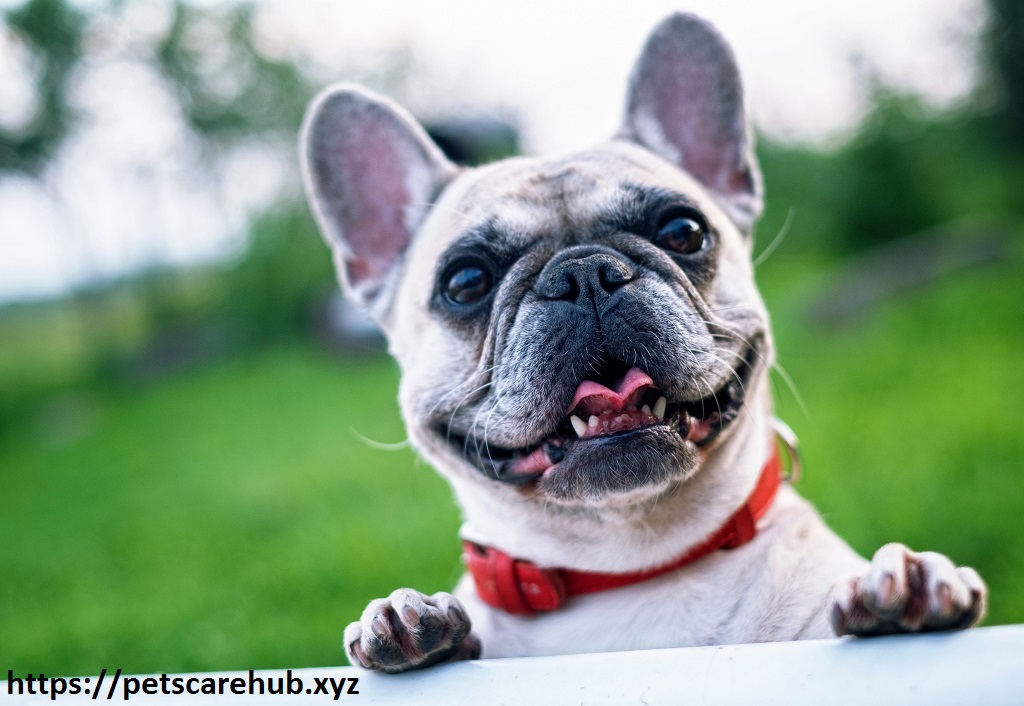
It is essential to monitor your dog’s pain levels closely and work with your veterinarian to develop an effective pain management plan of dog tumors. By effectively managing your dog’s pain, you can improve their overall quality of life and help them to remain as comfortable as possible.
Here are some important steps in managing your dog’s pain caused by tumors:
- Recognize signs of pain: Dogs have a natural instinct to hide their discomfort or pain. Therefore, it is crucial to look out for subtle changes in their behavior that might indicate they are experiencing pain. Some common signs include decreased activity level, changes in appetite, increased vocalization or whining, aggression when touched near the affected area, constant licking/grooming at one spot, reluctance to move/jump/run etc.
- Consult with your veterinarian: It is vital to work closely with your veterinarian in developing a targeted approach towards managing the dog tumors related pain. Your vet will assess your pet’s condition and prescribe appropriate medication/treatment based on factors such as size / type / grade / location of the dog tumors and any pre-existing medical conditions.
- Medication options: Different types of medications of dog tumors are available for treating chronic or acute pain in dogs. These include non-steroidal anti-inflammatory drugs (NSAIDs), opioid pain relievers, steroids, and other medications designed to target specific pain pathways in the body. Your vet will determine the appropriate medication for your dog’s specific needs.
- Alternative therapies: In addition to traditional medications, there are also alternative therapies that can help manage your dog’s pain of dog tumors. These may include acupuncture, massage therapy, or physical therapy. Be sure to consult with your vet before starting any alternative treatments.
- Comfort measures: Making your dog tumors as comfortable as possible is an important step in managing their pain. Provide them with a warm and soft bed to rest on, ensure they have easy access to food and water, and try to keep their environment calm and stress-free.
- Monitor progress: It is essential to monitor how well your dog tumors responds to the pain management plan. If you notice that the medications or treatments are not providing adequate relief, or if your dog’s condition worsens, notify your vet immediately so they can adjust the treatment plan accordingly.
Conclusion
Managing pain caused by a dog tumors can be challenging, but by working closely with your veterinarian and being attentive to your dog’s needs, you can help them stay as comfortable as possible throughout their treatment.
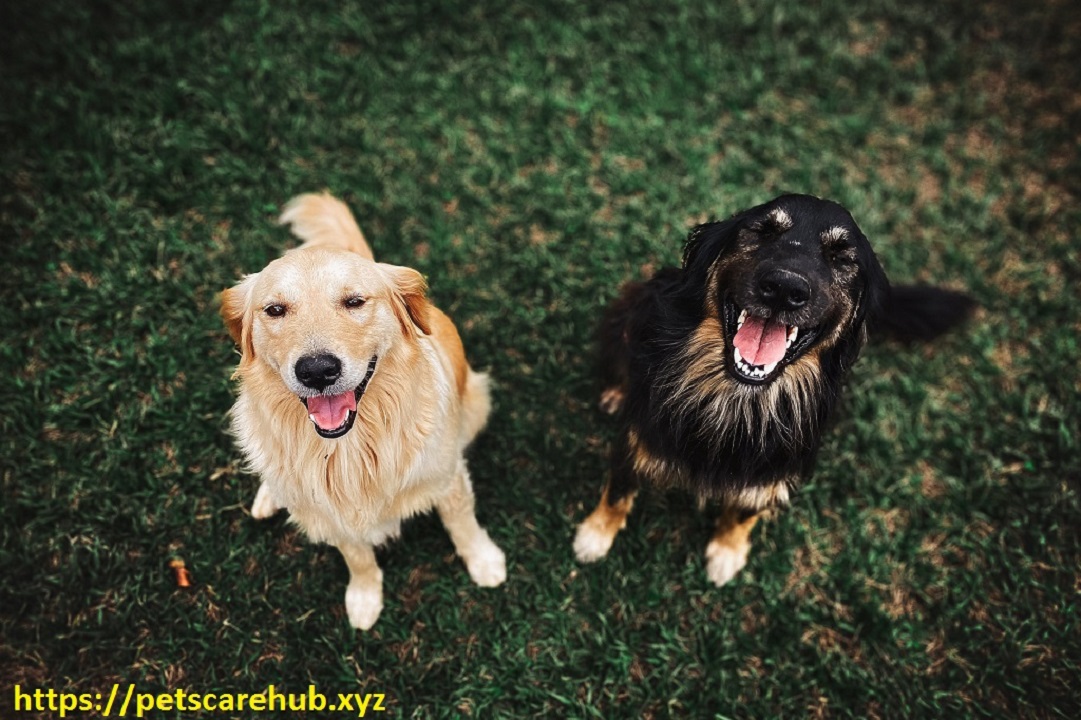
1 thought on “A Full Guide to the Most Common Types of Dog Tumors 2024”